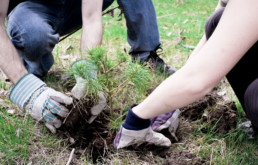Climate Ambassador Project: Citizen Centered Climate Resilience
Year Complete: 2018
Grant Amount: $35,000
Local Government: City of Cleveland, OH
Local Foundation: Sisters of Charity Foundation of Cleveland
Project Purpose
To mitigate and adapt to climate change by engaging residents in improving tree canopy, transportation mode shift, and entrepreneurship, delivering tangible outcomes for neighborhood resilience and equity.
Key Lessons Learned
Lessons learned about tools and tactics through the project that other sustainability directors could use to advance their work.
- Neighborhood-level, bottom up, citizens centered climate resilience work is challenging, especially when your city is made up of a wide variety of different types of neighborhoods. Starting small and working in a small number of neighborhoods is important work before taking any similar initiative citywide.
- For climate action to take hold, especially in lower income neighborhoods, it is crucial to connect climate impacts and action to day-to-day interests and needs of residents and neighborhoods.
- Identify other local organizations that are doing related work and find ways to cross promote and collaborate with them (e.g. the Climate Resilience and Urban Opportunity Initiative, Western Reserve Land Conservancy’s tree stewardship workshops, etc.)
- In general, the longer a workshop date is scheduled in advance, the better chance of a large turnout. Do not underestimate the time it takes to schedule, market and register people.
- In urban areas like Cleveland where many households do not have ready access the Internet, it is important to utilize more traditional methods for informing people about opportunities (e.g. hard copy newspapers, block club / committee meetings, partnering with places of worship, etc.) to ensure representative participation.
- If community development corporations (CDCs) are going to play a leadership role in neighborhood-level and resident-driven resilience work, it is important that they dedicate an employee to leading this work.
Lessons for developing a collaborative process between a local government sustainability director and local place-based foundation(s).
Above all, it is important not to look at the foundations solely as funders, but true partners in the project. Like any team, the collaborators need time to get to know each other and what the priorities are for each organization. This was especially true during this project, since both organizations experienced a leadership change mid-project. Looking forward, this same spirit of collaboration will be necessary in order to replicate the successes of this project to other neighborhoods in Cleveland and beyond.
Additional Information and Resources
The project had multiple successes, including planting 300 new trees around a local elementary school, and organizing an event to raise awareness about transportation issues. Read more about the work of the Sisters of Charity Foundation here.

